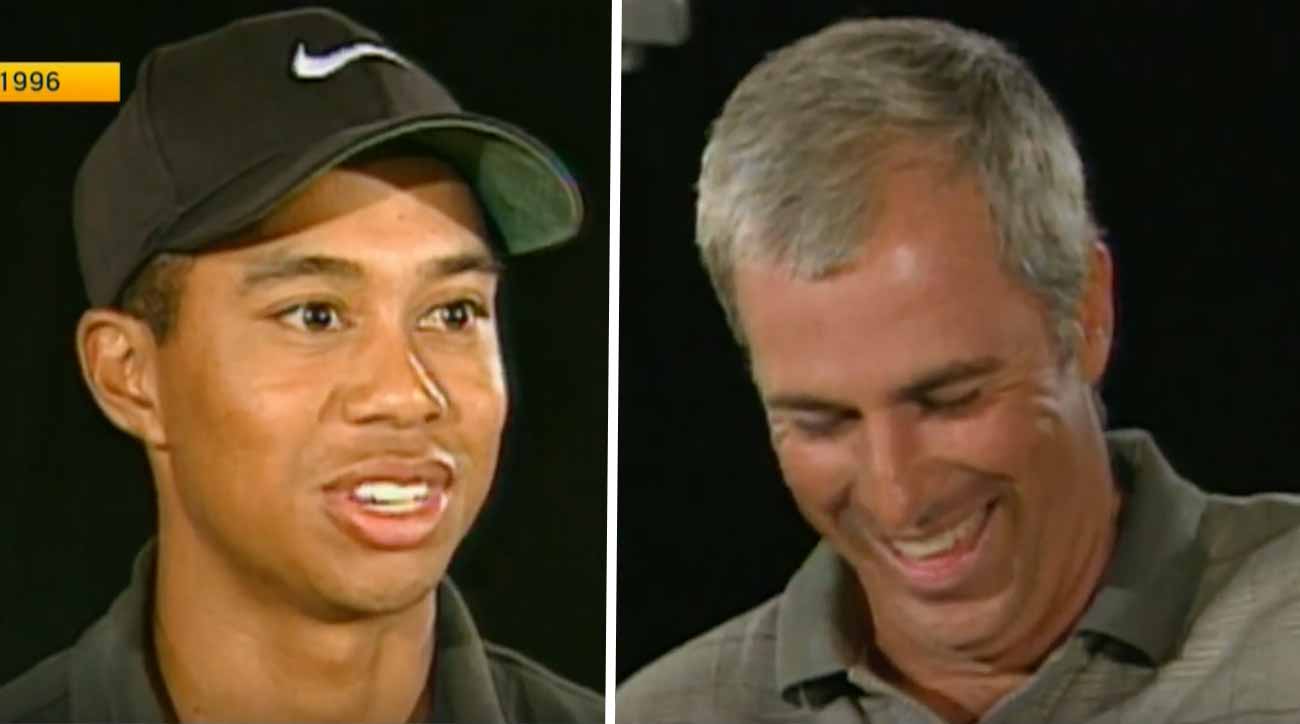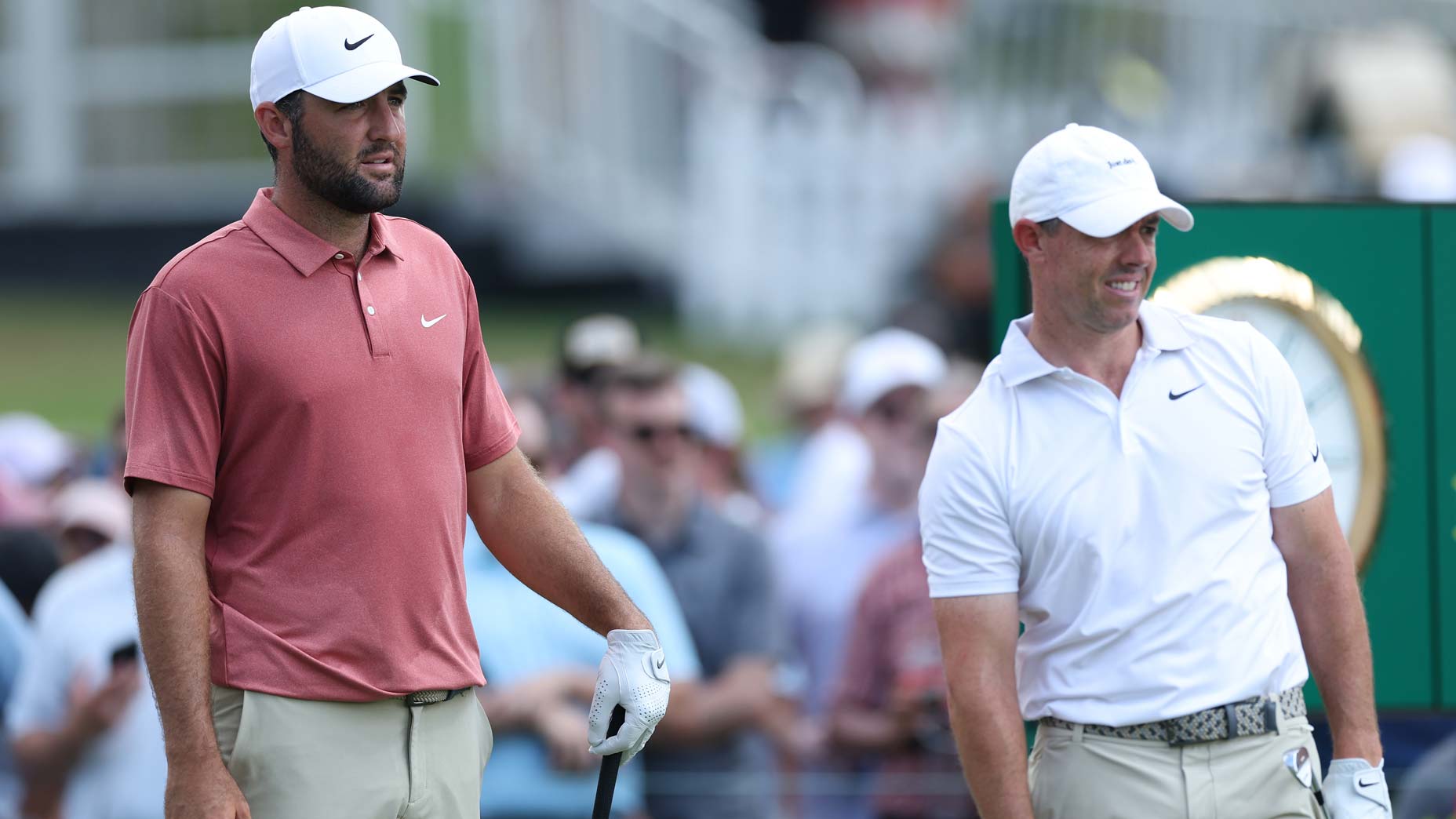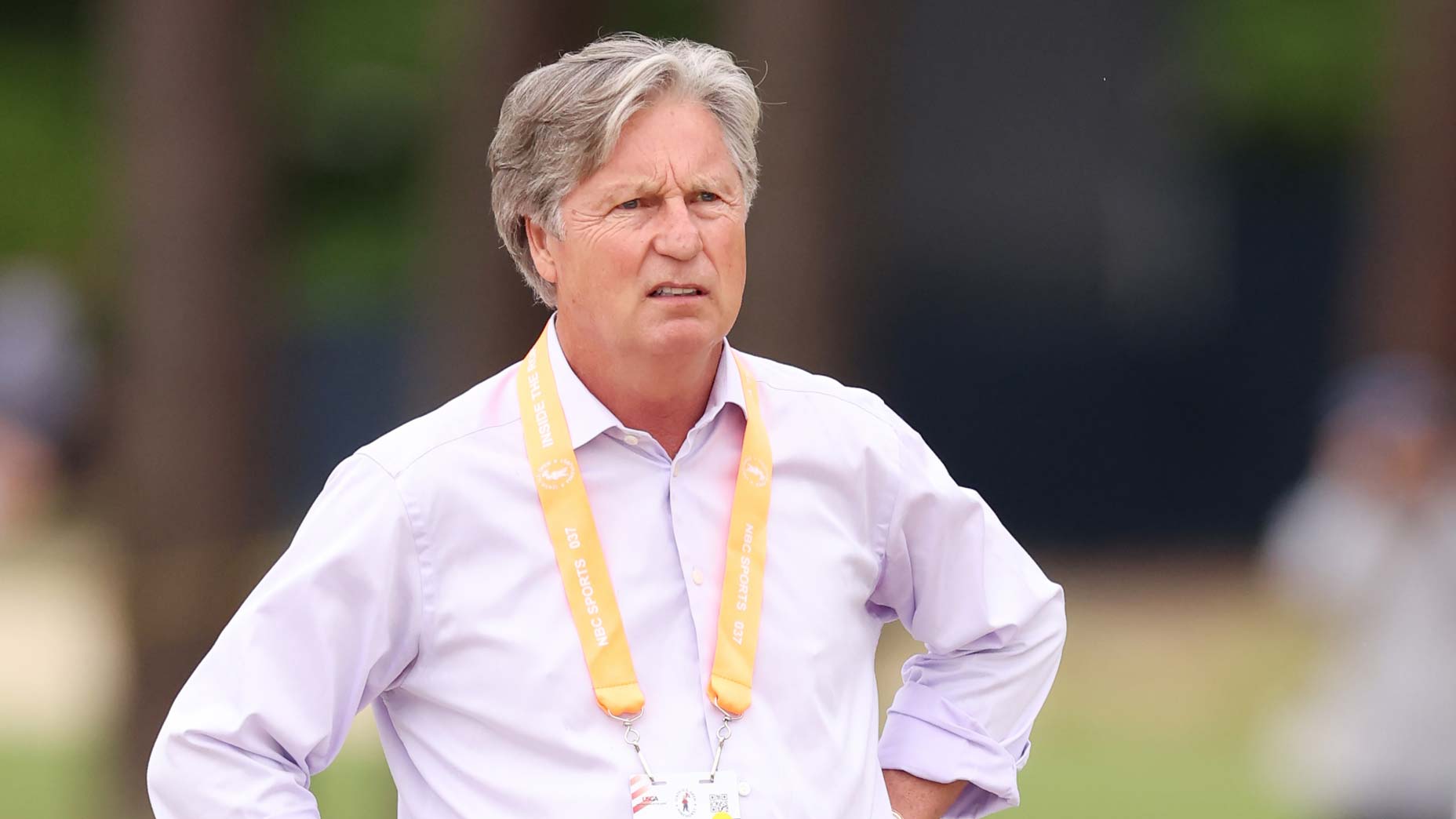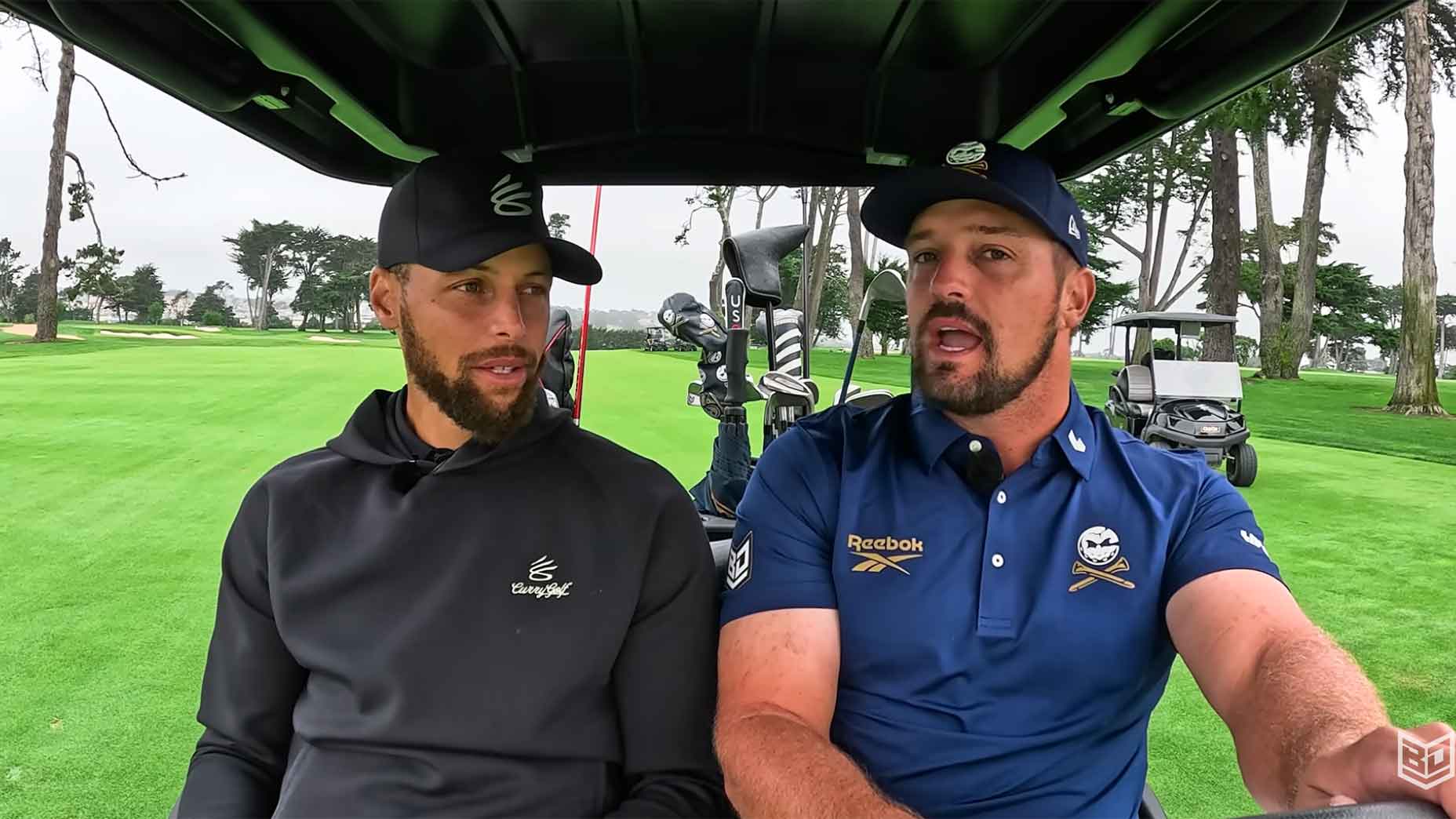 2 reasons why 2025 was one of the most important golf years … ever
2 reasons why 2025 was one of the most important golf years … ever
What Tiger Woods’ peculiar ‘You’ll learn’ interview with Curtis Strange taught us

Welcome back to the Tiger Woods YouTube Project, where we’re knee-deep in the ’90s tracking the progress of one Eldrick ‘Tiger’ Woods. We pick up today’s episode in 1996. Just before Woods teed it up in his first event as a professional, he sat down with Curtis Strange for a one-on-one interview — and it turned into an unforgettable TV moment.
Tiger Woods YouTube Project, Chapter 9: “You’ll Learn”
RELATED: Chapter 8 — Tiger’s first trip to Butler Cabin
The original interview itself was no doubt much longer, but one excerpt has stood the test of time (if you don’t know, you’ll see why in a moment). The clip is just shy of 90 seconds, but as always, there’s so much to discuss! To do so, I’ve brought in two masters of the deep dive, Brendan Porath and Andy Johnson (of the Shotgun Start podcast), to take the plunge into the meaning of this particular clip. First, watch along. Then see what we’ve come up with below.
1. Curtis Strange first asks Tiger Woods what would make for a successful week at Milwaukee, and Woods answers this way: “Two things. Play four solid rounds, get off to a good start today, if I can do that for three more days, I’ll be very happy, and a victory would be awfully nice, too.” Reasonable answer? (He would go on to finish 60th, but snagged his first Tour win four starts later.)
Andy Johnson, The Fried Egg (@the_wolk_yolk): Because we can look back, yes, it was reasonable. As Curtis Strange, a player who was out there competing and knew how challenging it is to win, or as a fan who understands the struggles of young players, it was a crazy response. At this point in time, we had seen so few players have immediate success in their 20s. The game had such a big learning curve that I think at the moment it was a pretty shocking answer.
Brendan Porath, SB Nation (@BrendanPorath): Exceedingly reasonable answer! This is a tough exercise because you must attempt to ignore all the success that came later and think of it purely in a vacuum of this time and circumstance. This is someone who has won and dominated all the way up to this point, and of course this is a new level. But I don’t see what’s wrong with the quote, and I think Strange’s initial reaction made it sound more bold than it actually is. Play good golf. Play four solid rounds. Get off to a good start. Then he adds that a victory would be awfully nice. Not that he expects to win. Not that he needs the win. Not that he will win. Just that it would be awfully nice, as an addendum to playing good golf for four rounds. That sounds like a reasonable answer for what would make a “successful week.”
Dylan Dethier, GOLF (@Dylan_Dethier): I think we’re in agreement here, and the only thing I’d add is that a year earlier, in his Masters debut, Woods shot 72-72-77-72 and said he was delighted with how the week went despite a T41. I think it’s actually a pretty healthy mindset for any aspiring top player to have — as long as that player knows he or she will fall short most of the time.
2. How would you describe Strange’s interview style here? Any moments that stick out?
Porath: The style is indignant, if that is a style. It’s confrontational and a bit abrasive. But this is a player, not Scott Pelley or some journalist interviewer by trade. It’s someone who has seen it all in the game, is a bit of a redass himself, and was one of the great players of the preceding decade on Tour. Tiger, as we’d learn, was a redass himself. So what sticks out to me about the style is the body language less than the words. Two redasses, being intense in different ways.
Tiger is deadpan and his head never moves, indicating a complete and intense commitment to what he’s saying and almost staring Strange into a confrontation. Strange’s style is shuffling around in his seat, shaking his head, looking away from Tiger to incredulously stare at the ceiling, around the room, down at his pad, etc. He’s constantly adjusting his facial expressions, head position, and posture. It’s a distinctly different approach and style of intensity and redassness.
Dethier: Your point about body language is really good. If this was a poker game, or a negotiation, or anything measuring composure, Tiger is ahead by a mile. Composed, certain, unemotional. Strange tips his hand early and often.

3. I was struck by the way Tiger defends his answer, despite pushback from Strange. He sticks to his guns. Where does that confidence come from?
Johnson: It comes from never-before-seen dominance at the Amateur level. Three straight U.S. Ams, three straight U.S. Juniors, a Western Am. At this point, Tiger had played with a lot of pros and had seen he could compete with them — and that he was better than most of them.
Porath: I think that’s right. He had total confidence in his abilities on the golf course based on what he’d done and seen. I think it also comes from the way his dad conditioned him throughout his upbringing, from something as simple as jingling his keys in Tiger’s backswing to always monitoring young Tiger for any sign of pouting. Earl loved him, but he didn’t make it easy and impressed upon Tiger that there would be plenty of outside noise coming his way. I think some of that conditioning is evident in this clip, as he’s already prepared and ready for hecklers, naysayers, and here a confronting inquisitor.
Dethier: I feel like the tide has shifted somewhat against Earl Woods in recent years, but revisiting these old clips makes me generally give him the benefit of the doubt. For a prodigy who has spent his entire life in the limelight, Tiger seems so — well-adjusted. That either means Earl was a better father than he usually gets credit for, or it means I’ve totally fallen for the illusion. I’d lean towards the former, though it’s probably some of each.
Johnson: I think recently there have been negative aspects of Earl’s fatherhood that have come to light, which in some cases are alarming. But two things can be true: Earl could have be a lousy father in the way he socialized Tiger but a great father when it came to golf. We all have our own flaws and weaknesses, which make us humans so interesting.

ADVERTISEMENT
4. Some versions of this clip cut off Strange’s answer before the laugh at the end — which does break the tension somewhat. We’re seeing Strange at an interesting point in his career, just a year removed from a Ryder Cup appearance but also a year away from becoming the lead golf analyst for ESPN/ABC. Does this reflect poorly on him? Does the laugh at the end make a difference?
Johnson: This is a good question. I think some of the context gets stripped from the entire conversation because in a 20-minute interview, only this part gets replayed. Strange was obviously one of the greats of the game from his generation, a three-time money winner, two-time U.S. Open champ. He was a guy who understood how difficult golf is. We rarely see any player come out and dominate immediately at the professional level in any sport. I think that this was more Strange not knowing exactly what was coming, which is understandable.
Porath: The interview and moment has been reduced over the years to the phrase, “You’ll learn.” While it is incredibly patronizing, there is context around it. The laugh lightens it at the end. Strange knows he’s on camera and there is a showman’s quality to picking on this new hotshot coming onto the scene. Part of me wonders if Strange’s initial goal was just trying to buddy up with Tiger, help him in some way, and then laugh with him there at the end. But he did say “You’ll learn” and given everything that followed for Tiger, those two words will live on in freezing cold take infamy.
Dethier: I think the laugh makes a little bit of a difference, but it doesn’t undo everything that preceded “You’ll learn,” either. We’ve got a good amount of context as is — the body language, the pregnant pauses, the line of questioning. The laugh helps, but I still found the totality of the exchange strangely antagonistic and off-putting.
I was surprised to read that Strange doubled down on the interview just a couple years ago. “As far as the [‘You’ll learn’] comment that went semi-viral, I think the world was thinking the same thing I said, for Christ’s sake,” he told Golfweek. “In the world of golf, sometimes second doesn’t suck.”
5. The description for this video is as follows: “Golf great Curtis Strange gives a naive Tiger Woods a valuable golf lesson on 08/28/96.” I would say, with the blessing of hindsight, that was NOT my takeaway from watching this clip. What’s yours?
Porath: Aside from the observational above? To never, under any circumstances, tell someone — whether it’s a teammate, spouse, colleague, or even child you’re trying to coach — “You’ll learn.” Aside from it being patronizing and really not adding any value, there’s a chance, however small, that you will, in fact, be the one learning. The other takeaway is that the Internet never forgets and it will keep this clip alive forever. There were probably many of these moments when other phenoms came up where the person in the Strange spot was proven appropriate or accurate, or if they weren’t, it was lost to time.
Dethier: I’m laughing and nodding at Brendan’s response, because I think it speaks to how perilous it is for any of us to assume that our experience will be mirrored by someone younger or less experienced who is entering a similar situation. In golf, the smart money is usually against the supposed “sure thing,” but there’d never been a thing quite as sure as Tiger. In the end, I’d say it was Tiger giving the lesson here, not Strange.
Johnson: Reading your responses sparked a cross-sport memory of when Isiah Thomas froze out Michael Jordan in his first All-Star appearance, hardly passing the ball to the future superstar. It was meant to be an ego check from Thomas, the veteran, to Jordan, the burgeoning young star. In the end, the move gave Jordan more motivation and heightened the rivalry between the two. Long story short, Jordan eventually supplanted Thomas as the king of the Eastern Conference. Fast-forward to 1992, when it came time to pick the Dream Team, Jordan was the reigning MVP of the league — and Isiah Thomas was a notable snub from the 12-man squad.
At this moment, Strange was on the downside of his career but not more than five years removed from being one of the biggest names in the game. He, like Thomas, probably viewed this as an opportunity to check a young phenom who was stealing all the media’s attention. While there was no Dream Team snub in return, Strange HAS had to deal with this clip being run millions of times since. In both cases, hindsight reveals these were really unadvisable actions that underestimated the eventual heights of greatness that Jordan and Woods would reach.

6. What, if anything, does this teach us about Tiger Woods?
Johnson: Tiger brought a different attitude and expectation to the game than the “status quo” rookie. Most players turn pro and hope to make it; Tiger turned pro and expected to dominate. That’s a mentality few players have ever had.
Dethier: It teaches us a ton about Tiger. It demonstrates his mental control. His composure under uncertain circumstances. His willingness to stand out. His goal-driven approach. Most of all, I think it teaches us that any “back-down” instinct had been trained completely out of Tiger. That same training has meant he has commanded every single room he’s set foot in since this interview some 24 years ago.
Porath: As I noted, I think it shows us a prepared Tiger as he turned pro. The conditioning from his father, the racism, people looking askance at someone so good who looked so different — he probably experienced it all coming up as a phenom in junior and amateur golf, and that had him ready for whatever attendant backlash was coming with the hype as he turned pro. This was perhaps the best way for him to burst onto the professional scene, but it was not sustainable.
As a supreme talent in his 20s, he could be singularly focused and entrenched in this approach. Essentially, “I only go to tournaments to win. If you find that offensive, that’s your problem, not mine.”
This worked in the early stage of his career but had to change over time. As Gary Smith wrote in Sports Illustrated, “The machine will win.” The celebrity fishbowl eventually came for him. He lost his way. He lost his health. And now he gives interviews talking about the “blessing” and “gift” of just being able to tee it up in competitive tournaments — a far cry from what we see in the interaction with Strange. Both approaches worked in their place and time.
For more Tiger Woods YouTube Project:
CHAPTER 1: What Tiger’s first-ever TV appearance taught us
CHAPTER 2: Here’s the first time we ever saw Tiger play golf
CHAPTER 3: Was this Tiger’s most revealing interview ever?
CHAPTER 4: What’s it like when Tiger comes to your hometown?
CHAPTER 5: Here’s what Earl “trash-talking” Tiger looked like
CHAPTER 6: What was it like to play on Tiger’s high school team?
CHAPTER 7: 10 obscure facts about Tiger Woods, high school senior
CHAPTER 8 — Tiger’s first trip to Butler Cabin
To receive GOLF’s all-new newsletters, subscribe for free here.
ADVERTISEMENT






